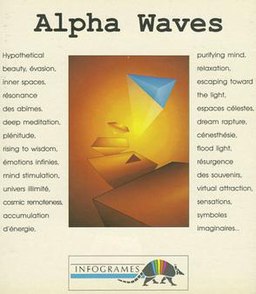Alpha Waves
| Alpha Waves | |
|---|---|

European cover
|
|
| Developer(s) | Infogrames |
| Publisher(s) | Infogrames (International)/Data East (North America) |
| Designer(s) | Christophe de Dinechin |
| Platform(s) | Amiga, Atari ST, MS-DOS |
| Release date(s) | August 1, 1990 |
| Genre(s) | Platformer |
| Mode(s) | Single player (MS-DOS), multiplayer (Atari ST, Amiga) |
Alpha Waves is an early 3D game that is combines labyrinthine exploration with platform gameplay. It combined for the first time full-screen, six-axis, flat-shaded 3D with 3D object interaction (like bouncing on a platform). Alpha Waves was an abstract game with a moody, artistic presentation, named for its supposed ability to stimulate the different emotional centers of the brain with its use of color and music.
It was developed initially for the Atari ST by Christophe de Dinechin, and later ported to the Amiga and DOS. The DOS port was done by Frédérick Raynal, a notable game designer who would go on to develop Alone in the Dark (often abbreviated AitD), and Little Big Adventure. He has said that his work on Alpha Waves was a major inspiration for the 3D engine for Alone in the Dark. The PC version was also localized in North America by Data East, and retitled Continuum. Infogrames may have also published their own version in the US under the original title, and it was also released as a part of no less than two Infogrames compilations, on which it retained its original name.
In 2009, Christophe de Dinechin released the complete assembly language and GFA BASIC source code for the Atari ST version. There is also a started PC port in C++ on sourceforge by the original author.
Alpha Waves features two main modes of play: Action and Emotion. The core gameplay in both is the same.
Players guide one of six crafts (which are little more than geometric shapes in many cases) onto trampoline-like platforms. On these platforms, the player bounces automatically, higher, with each jump, until he reaches the maximum height possible for that platform (some are stronger than others). Every room in the game is a cube, and the walls contain doorways leading to other rooms. In this way, players have to work their way through the game's rooms, and reach different areas based on different emotions.
...
Wikipedia
